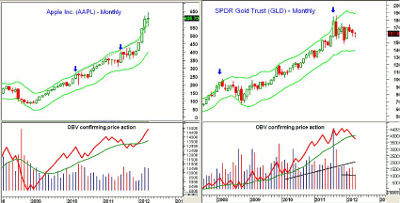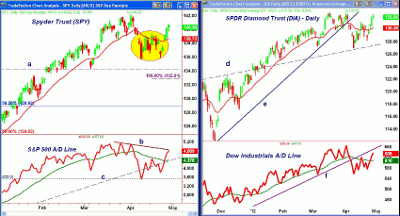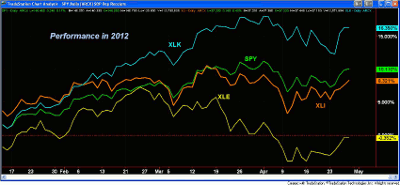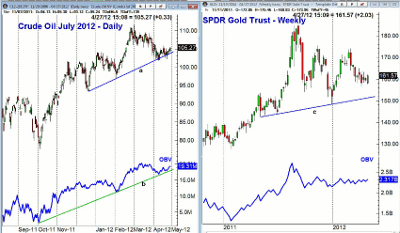If this surprisingly good week makes you want to jump back into stocks with both feet, be patient, writes MoneyShow’s Tom Aspray. A cautious approach will pay off in the leading sectors and plays he has uncovered.
The strong earnings last week were indeed enough to push the stock market higher, with the Spyder Trust (SPY) showing a nice gain of 2.6%, while the PowerShares QQQ Trust (QQQ) was up 3.2%.
Of course, it was earnings from Apple (AAPL) that saved the day. After trading as low as $555 on Tuesday afternoon, it surged as high as $618 early Wednesday in response to the reported 35 million iPhones sold.
Apple (AAPL) looks ready to close April above its monthly Starc+ band for the third month in a row. For those who are not familiar with Starc band analysis, these bands identify extreme price levels in any market. When prices are at or above the Starc+ bands, it is a high-risk time to buy.
Consecutive monthly closes above the Starc+ band are quite rare, and as the chart of SPDR Gold Trust (GLD) reveals, the ETF has only closed above its Starc+ band for two consecutive months once since 2008. In fact, if we look at the gold futures, they were only able to close above the monthly Starc+ band for three months prior to the 1980 top.
Before the hate mail starts overflowing my inbox, this does not mean that I am negative on Apple or its products. It does point out that, statistically, it has deviated too far from the mean. This increases the odds of an even a sharper drop in the coming months.
In August and September 2011, I pointed out that GLD was also trading above its monthly Starc+ band. It has been correcting for the past seven months. The major trend is still positive for GLD, so a deeper correction in AAPL does not mean a change in the major trend.
The stock market also did a good job of ignoring the worrisome events in the Eurozone. The weekend elections in France will now have to be resolved with a runoff election on May 6. In the Netherlands, the prime minister was forced to resign, as support for the German-led austerity plan throughout Europe is diminishing.
German state elections will also be held May 6, as will parliamentary elections in Greece. There seems to be a rising tide of public opinion that the forced austerity is just making matters worse. Italian Prime Minister Mario Monti, who is trained as an economist, has been pointing out the pitfalls of the current course.
Also, the markets ignored S&P’s downgrade of Spain’s debt, which dropped it below the ratings of Fitch and Moody’s. Stocks and the British pound seemed to shrug off news that the UK’s economy had dropped back into a recession in the first quarter.
As this graphic from The Wall Street Journal illustrates, continued deterioration in the Eurozone economies will eventually take its toll on the rest of the world. Private lending will dry up, there will be less demand for exports from the emerging markets, and emerging currencies will continue to weaken.
Last fall, the potential impact of European problems on the US stock market or economy did not concern me as much they do now. Seven months ago, sentiment was very negative on both the US economy and the stock market. Stock prices are also at much more attractive levels.
Last week’s sharp drop in durable good orders and the disappointing preliminary reading on first-quarter US GDP may also be a sign that our economy is slowing down. So what does that mean for our stock market?
Technically, the intermediate-term trend is still positive, but despite last week’s strength, it is not clear yet that the market’s correction is indeed over. In any case, stock selection will be even more critical in the coming months.
There were some encouraging signs in two key sectors last week, homebuilders and energy stocks. As discussed in more detail Friday, the surge in volume in the homebuilding stocks indicates that their correction is over. Also after a disappointing first quarter, energy stocks may have finally bottomed out, and they may be enough to push the market above the recent highs.
We have a full slate of economic news this week, and the focus is likely to be on the health of the manufacturing sector and jobs. Monday, we get the Dallas Manufacturing Survey and the Chicago Purchasing Managers Index. This is followed Tuesday by the ISM Manufacturing Index and construction spending.
The ADP Employment Report comes out on Wednesday along with factory orders. The recent disappointing trend of higher unemployment claims will have many watching Thursday’s weekly jobless claims report.
Also, the ISM Non-Manufacturing Index on will be released on Thursday, followed by the monthly jobs report on Friday. If the stock market is weak heading into this report, it could give up some of its recent gains.
|pagebreak|WHAT TO WATCH
After Monday’s drop, stocks had a great week. Many of the major averages rebounded, and the S&P 500 closed above key resistance at 1,400. The market internals were strong late in the week, and the Advance/Decline (A/D) lines are at or above key resistance.
Even though individual investor sentiment is negative enough to help fuel another leg to the upside, the financial newsletter writers are still too bullish.. If the A/D lines can move to convincing new highs, it will be a sign that the early April highs in the major averages can be exceeded by a wide margin.
The action early in the week should tell us more. If there are clear signals that the market correction is over, we are still likely to see a one- or two-day setback that will present a better entry point on the long side. There are still quite a few stocks with attractive patterns that are close enough to monthly support to give good risk-reward entry points.
S&P 500
The Spyder Trust (SPY) broke out of its two-week trading range (in yellow) last week, and managed to close well above the 20-day EMA, which is now at $138.75. This now represents initial support, with stronger levels between $137.50 and $138.
The daily Starc+ band is just above Friday’s close at $141.20, with the recent highs at $142.21 representing the next major resistance. If it is overcome, the next major target is $144.
The A/D line closed just barely above the bearish divergence resistance from the recent highs (line b). As I noted last week, “A move through the downtrend (line b) will signal a resumption of the intermediate-term uptrend.”
Last Thursday, the A/D line did close back above its former uptrend (line c) and its WMA. Historically, the break of the uptrend could be an early warning that a more serious divergence could form in the coming weeks.
Dow Industrials
The SPDR Diamonds Trust (DIA) was very strong last week, as it closed just barely below the April 2 high at $132.68. There are additional upside targets in the $134 area.
The Dow Industrials’ A/D line has also moved well above its flat WMA, but has not yet closed above its former uptrend (line f) that goes back to the October 2011 lows.
There is first support now at $130.50 to $131, with additional strength in the $128.50 to $129 area. It would take a drop below $128 to reverse the positive momentum.
NEXT: Tech Stocks, Sector Focus, and Tom’s Outlook
|pagebreak|Nasdaq-100
The PowerShares QQQ Trust (QQQ), with its 18% holding in Apple (AAPL), had a fine week, closing just below the resistance in the $67.50 to $68 area.
It is again bumping into the upper boundaries of is recent trading channel (line a). Once above the prior highs at $68.55, the next resistance is in the $70 area.
The Nasdaq-100 Advance/Decline (A/D) line closed above its WMA and its downtrend (line c) on Friday. It is still well below the April highs, and could form another negative divergence if QQQ makes a new high this week.
Russell 2000
The iShares Russell 2000 Index Fund (IWM) has rallied impressively from the important support around $78. There is still strong resistance in the $83.50 to $84.66 zone.
The Russell 2000 A/D line has moved back above its declining WMA ,but is still below the bearish divergence resistance from the February and March highs (line g). The A/D line shows a pattern of lower lows (line h), which is a sign of weakness.
Sector Focus
For the week, the leading performer was the Select Sector SPDR Consumer Discretionary (XLY), up 4%. The Select Sector SPDR Consumer Staples (XLP) and the Select Sector SPDR Health Care (XLV) were up 1.5% and 1.6%, respectively.
The percentage change chart shows that the Select Sector SPDR Technology (XLK) is still the star performer for the year, with a gain of over 16%. Next in line is the Spyder Trust (SPY), which is itself closely followed by the Select Sector SPDR Industrials (XLI). Several of the key industrial companies, like General Electric (GE), reported strong earnings.
The Select Sector SPDR Energy (XLE) is still negative for the year, but did improve last week. If the volume improves, a short-term bottom formation could be completed this week.
NEXT: Oil, Metals, and Tom’s Outlook
|pagebreak|Crude Oil
The July crude oil contract finished last week up slightly, trying to hold the uptrend from the late 2011 lows (line a).
A close above $106.50 would improve the short-term outlook, although the major resistance above $109 needs to be overcome to signal higher prices.
Precious Metals
The SPDR Gold Trust (GLD) closed up $2, turning higher late in the week. The weekly chart shows fairly narrow ranges over the past month, suggesting that the market may be sold out.
The criteria for a bottom in GLD has not been fulfilled (see: Gold: 3 Signs Will Confirm the Bottom). However, the seeming lack of interest in gold and disappearance of the gold bulls suggest we may be very close to a bottom. We could get new buy signals next week, but I cannot rule out one more drop first.
The weekly on-balance volume (OBV) is holding in a tight range with a slight upward bias.
The iShares Silver Trust (SLV) finally broke the support at $30, but there was little follow-through selling, as SLV quickly rebounded. This is a positive sign, and may be signaling a sold-out market.
The Week Ahead
The stock market’s strong performance last week caught me a bit by surprise, as the technical formations did favor a deeper correction. This is still possible next week, but there are now more stocks that are looking attractive.
The stops on the existing positions in the “Charts in Play” portfolio have been raised to the point where they are protected against any meaningful loss. I will be concentrating on stocks in the coming weeks that have the most compelling monthly charts. These are likely to be the best performers with the lowest risk as we head into the more difficult summer months.
For those who are underinvested or anxious to buy, I still recommend a patient approach. This worked well for my positions in the homebuilding stocks, which came to life this week and closed with double-digit gains.
- To view the current “Charts in Play” portfolio and updated stop levels, please click here.
- Also, don’t forget to read this week’s Trading Lesson, 3 Ways to Predict Post-Earnings Shocks.
























